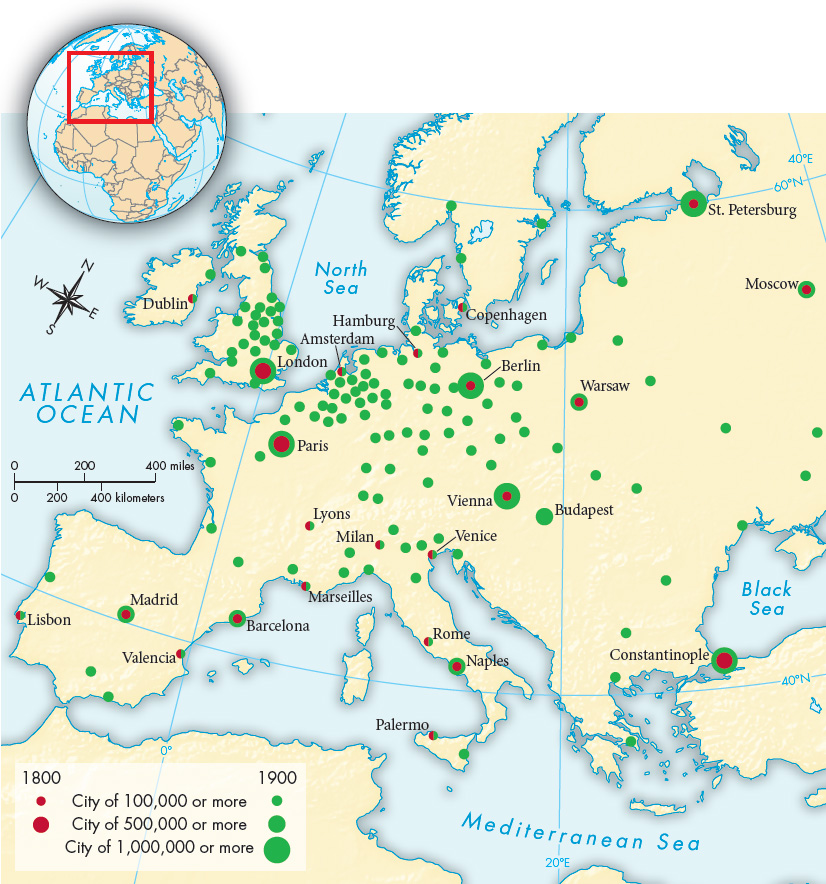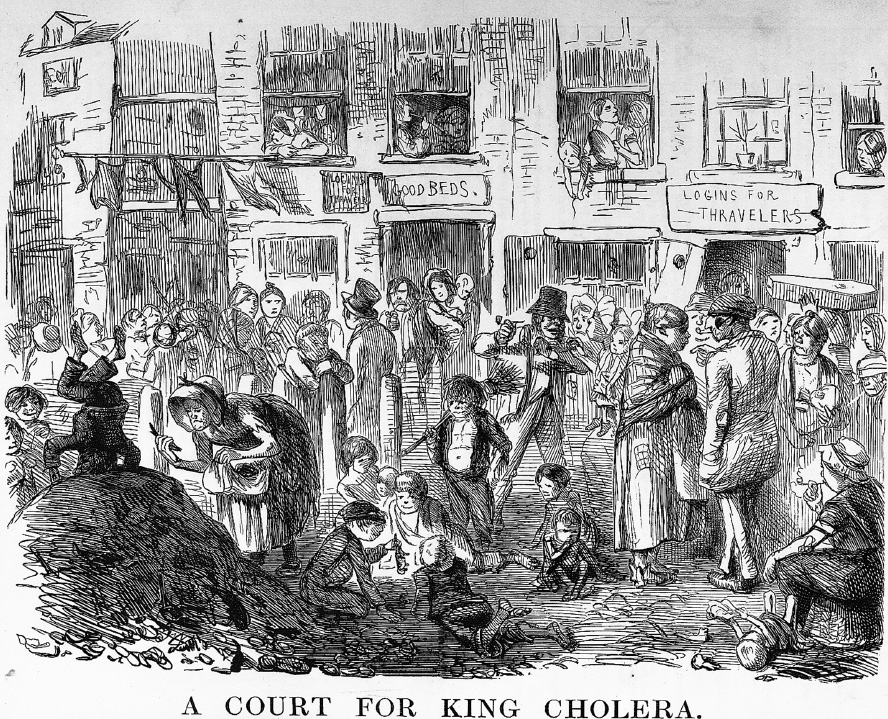Industry and the Growth of Cities
ONLINE DOCUMENT ASSIGNMENT
Life in the Modern City on FilmHow did people respond to the challenges brought on by rapid urbanization? View film footage that captures new developments in city life — from mass transit to waste disposal — and then complete a writing assignment based on the evidence and details from this chapter.
The main causes of the poor quality of urban life — deadly overcrowding, pervasive poverty, and lack of medical knowledge — had existed for centuries. Because the typical city had always been a “walking city,” with no public transportation, great masses of people needed to live in close proximity to shops, markets, and workplaces. Packed together almost as tightly as possible, people in cities suffered and died from the spread of infectious disease in far greater numbers than their rural counterparts. In the larger towns, more people died each year than were born, on average, and urban populations maintained their numbers only because newcomers continually arrived from rural areas.
The Industrial Revolution exacerbated these deplorable conditions. The steam engine freed industrialists from dependence on the energy of fast-flowing streams and rivers so that by 1800 there was every incentive to build new factories in urban areas, which had many advantages. Cities had better shipping facilities than the countryside and thus better supplies of coal and raw materials. Cities had many hands wanting work, for they drew people like a magnet. And it was a great advantage for a manufacturer to have other factories nearby to supply the business’s needs and buy its products. Therefore, as industry grew, already overcrowded and unhealthy cities expanded rapidly.
Great Britain, the first country in the world to go through the early stages of the Industrial Revolution, was forced to face the acute challenges of a changing urban environment early on. In the 1820s and 1830s the populations of a number of British cities increased by 40 to 70 percent each decade. The number of people living in cities of 20,000 or more in England and Wales jumped from 1.5 million in 1801 to 6.3 million in 1851 and reached 15.6 million in 1891. Such cities accounted for 17 percent of the total English population in 1801, 35 percent as early as 1851, and fully 54 percent in 1891. Other countries duplicated the English pattern as they industrialized (Map 22.1). (See “Primary Source 22.1: First Impressions of the World’s Biggest City.”)
MAPPING THE PAST

ANALYZING THE MAP Compare the spatial distribution of cities in 1800 with the distribution in 1900. Where in 1900 are large cities concentrated in clusters?
CONNECTIONS In 1800, what common characteristics were shared by many large European cities? (For example, how many big cities were capitals or leading ports?) Were any common characteristics shared by the large cities in 1900? What does this suggest about the reasons behind this dramatic growth?
Except on the outskirts, early-nineteenth-century cities in Britain used every scrap of available land to the fullest extent. Parks and open areas were almost nonexistent. Developers erected buildings on the smallest possible lots in order to pack the maximum number of people into a given space. Narrow houses were built attached to one another in long rows. These row houses had neither front nor back yards, and only a narrow alley in back separated one row from the next. Other buildings were built around tiny courtyards completely enclosed on all four sides. Many people lived in extremely small, often overcrowded cellars or attics. “Six, eight, and even ten occupying one room is anything but uncommon,” wrote a Scottish doctor for a government investigation in 1842.
These highly concentrated urban populations lived in extremely unsanitary and unhealthy conditions. Open drains and sewers flowed alongside or down the middle of unpaved streets. Toilet facilities were extremely primitive and inadequate. In parts of Manchester, as many as two hundred people shared a single outhouse. Such privies filled up rapidly, and since they were infrequently emptied, sewage often overflowed and seeped into cellar dwellings. Moreover, some courtyards in poorer neighborhoods became dunghills, collecting excrement that was sometimes sold as fertilizer and sometimes simply continued to accumulate. By the 1840s there was among the better-off classes a growing, shocking “realization that,” as one scholar put it, “millions of English men, women, and children were living in shit.”1
The environmental costs of rapid urbanization and industrialization were enormous as well. Black soot from coal-fired factories and train engines fouled city air, and by 1850 the River Thames was little better than an open sewer.
Who or what bore responsibility for these awful conditions? The crucial factors included the tremendous pressure of more people and the total absence of public transportation. People simply had to jam themselves together to get to shops and factories on foot. In addition, government in Great Britain, both local and national, only slowly established sanitary facilities and adequate building codes. Scientific understanding of the causes and consequences of urban crowding advanced slowly, and some elites rigidly opposed government action. Certainly, Great Britain had no monopoly on overcrowded and unhealthy urban conditions; many continental cities were every bit as bad.
Most responsible of all was the sad legacy of rural housing conditions in preindustrial society combined with appalling ignorance of germs and basic hygiene. When ordinary people moved to the city, housing was far down on their list of priorities, and they generally took dirt for granted. One English miner told an investigator, “I do not think it usual for the lasses [in the coal mines] to wash their bodies; my sisters never wash themselves.” As for the men, “their legs and bodies are as black as your hat.”2
